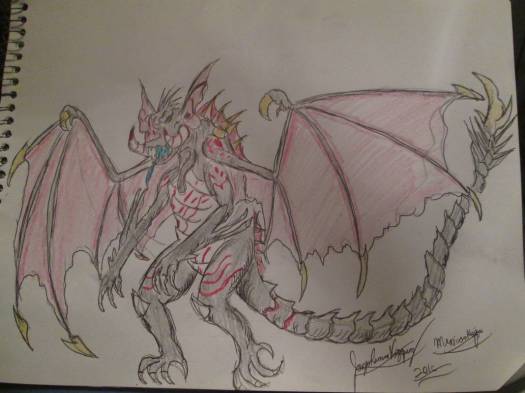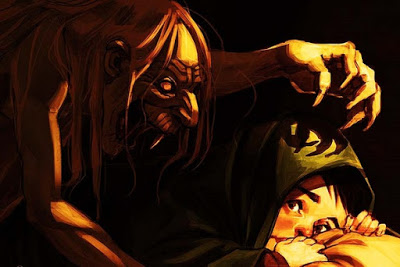
Chances are when you think of vampires you’ll think of Eric Northman, Drusilla, Barnabas Collins, or any of the other fanged creatures-of-the-night that populate modern culture, including Mara from Love Lies Bleeding. The vampires we’re familiar with are (generally) human looking, powerful, often charismatic and attractive, with a thirst for blood and a dislike of stakes. But that wasn’t always the case. History and folklore are full of vampires that are nothing like what we’ve come to expect. Here are five examples…
Vetala

Also known as vetaal or baital, the vetala is a blood-drinking demon in Hindu mythology that haunts burial grounds and crematoria, hangs upside down (like a bat) from trees, and possesses dead (or occasionally living) humans or animals. Not unlike the vampires on Buffy, the demon sets up shop in the body it’s possessing, while the original soul that inhabited said body is “completely gone.” Unlike the vampires of Buffy, the vetala retains none of the memories of the person it’s possessing. As well, destroying the body doesn’t destroy the demon, which simply moves on to the next handy body. Vetala are chaotic, revelling in the damage they cause, including driving people insane and killing children. Interestingly, some vetala are not evil; there’s even a Disney Channel series in India where a harmless vetala is friends with a boy. It’s also possible that Bram Stoker was inspired by tales of vetala before he wrote Dracula.
Revenant

There’s some debate about what revenants actually are. It has been argued that they are a type of vampire, zombies, or simply generic undead. Since the word itself means “one who returns,” it could refer to anything from a ghost to (technically) someone coming back from a long trip. Augustin Calmet wrote in the 18th century that revenants were created by sorcerers “who sucked the blood of victims.” Most historical accounts agreed that revenants are caused by the restless spirits of wicked people re-animating their corpses. Whatever a revenant is, stories show a number of similarities with classic vampires, from their bodies being swollen with blood (usually from gorging on it); to only being able to move about at night; to needing their heads and/or hearts removed and destroyed in order to finally stop them. Illness and death almost always follow in a revenant’s wake. While vampires are said to require blood as sustenance, a revenant doesn’t need the blood it consumes. Another difference is that revenants, unlike vampires, decompose.
Draugr

Draugr (or draug, pl. draugur, AKA aptrganga) is essentially a Norse revenant. Unlike other revenants, draugur can increase their size at will, are motivated by treasure (as well as revenge and the general desire to do damage), and are not affected by sunlight (although they prefer the dark). Draugur have magical abilities and can shape shift (one form they were known to take was a cat that would sit on a sleeping person’s chest, getting steadily heavier until the victim suffocated). They can also rise from their graves as wisps of smoke or pass through solid rock. Draugur can enter the dreams of the living, leaving a “gift” as assurance that they were really there. Draugur kill their victims (both human and animal) by draining their blood, but can also kill by crushing, devouring, or driving their victims mad. They were also thought to run animals to death by chasing or riding them. They can be killed via burning, dismemberment, destruction of the body, or simply by eventual decay.
Izcacus

(AKA Aizhakos) A pagan shaman on trial during the Hungarian Inquisition described a demon called Izcacus (meaning blood drinker), which could be called forth to destroy the enemies of the pagans. The name has ancient Turkish roots, and may have been originally spread by migrating tribes who were themselves influenced by the Assyrians. Specific information on the Izcacus is hard to find, but if it does have roots in Assyrian vampire beliefs, it could (like other Assyrian vampires) be a violent, merciless spirit or demon that devours its victims’ blood and flesh.
Guaxa

Originating in Spain, the guaxa (AKA guaja or guajona) is an ancient vampire resembling an old hag (think stereotypical witch) with bright eyes and bird legs (any relation to Baba Yaga?) She sucks blood (preferably from children) with her single long tooth/fang. The guaxa sneaks into homes at night through keyholes and chimneys, and slowly drains victims over the course of weeks, causing them to waste away. Unlike most vampires, they are born, not turned. One source claims that the guaxa’s weaknesses include silver, antlers, running water, and magical amulets, but I couldn’t find any corroborating sources, so it may not be accurate.
Have you heard of these vampires? Which do you think is scariest? Tell me in the comments…
Further Reading
Get more vampires-- download my books:

Love Lies Bleeding: Smashwords, Barnes & Noble, Kobo, Apple Books
FREE Blood Magic: Smashwords, Barnes & Noble, Kobo, Apple Books
FREE Tooth & Claw: Smashwords, Barnes & Noble, Kobo, Apple Books
If you prefer paperback to an ebook, order Love Lies Bleeding from Bookshop – a portion of each sale goes directly to independent bookstores, as well as to myself. Thank you for supporting indie! ♥
Make sure to check out my original post, 5 Vampires You May Not Have Heard Of.
Three Famous Vampires in India
La Guaxa Es La Vampiresa Asturiana
The Monster Blog of Monsters: Guajona
Cheers,
Aspasía S. Bissas

No comments:
Post a Comment